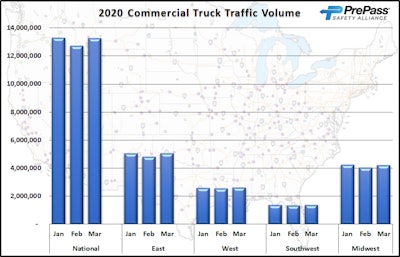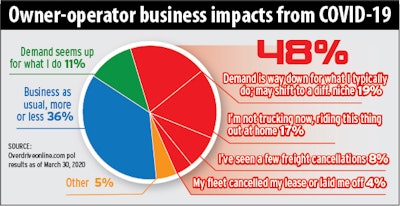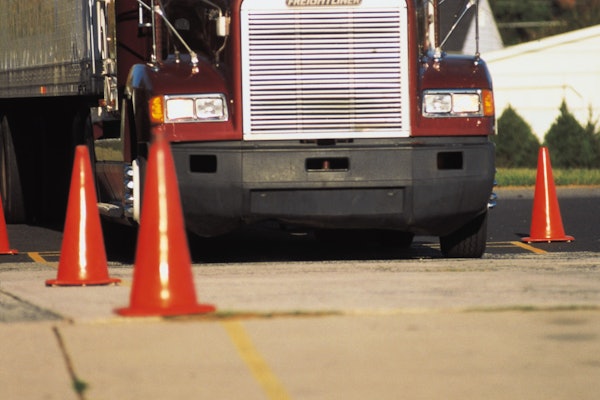 March truck volumes steady as observed via counts collected at PrePass weigh station bypass sites.
March truck volumes steady as observed via counts collected at PrePass weigh station bypass sites.Owner-Operator Independent Drivers Association President Todd Spencer delivered a call this weekend to the President of the United States in the form of a letter that warns of the potential for the supply chain to deteriorate quickly if working truckers don’t get the support they deserve along high-risk haul routes in the form of readily available personal protective equipment, testing and more.
“Small-business truckers and professional drivers are the vital link” in the entire nation’s supply infrastructure, Spencer wrote, “putting their lives on the line for the good of the nation. … They run in and out of the hot zones and without question they are exposed. They don’t have access to PPE or any practical means to know when they may be falling ill or any practical solution if they need treatment or self-isolation.”
Clickhere to view our full coverage of the coronavirus' impact on the trucking industry from the leading industry publications of Commercial Carrier Journal, Overdrive, Truckers News and Trucks, Parts, Service.
As it stands, a combination of self-quarantine in the truck and/or at home is a method often enough employed, as shown in Gary Buchs’ piece on the Overdrive Extra blog today, the latter with risk for loved ones who may be there. “Right now, professional drivers are busting their butts to care for the nation. Their hard work and personal sacrifice should not include their health or even their lives if at all possible or preventable,” Spencer wrote, warning that a “tremendous reduction in drivers willing to risk everything for the rest of us” could be the result of too little support.

There are some testing options on the road now in the form the UrgentCareTravel clinic network’s coronavirus video consult option — depending on results of the telemedical consult and the location of the affected driver, one of 16 UCT sites at Pilot Flying J locations around the nation may be best equipped to handle a particular driver’s COVID-19 test, says UCT’s Mitch Strobin. “We have the PPE and the COVID-19 test kits at all of our clinics,” Strobin emphasizes.
For the safety and health of all involved, though, if experiencing symptoms, he adds, “drivers should use our telemedicine COVID-19 evaluation service first before coming to the clinic.”
There is some evidence readers in Overdrive‘s audience of owner-operators have chosen to ride out the COVID-19 crisis at home rather than trucking over the road, as 17% of poll respondents said as of early last week.
 A little more than one-third of owner-operator respondents (36%) to recent Overdrive polling reported no change in business so far, yet nearly half reported a negative effect.
A little more than one-third of owner-operator respondents (36%) to recent Overdrive polling reported no change in business so far, yet nearly half reported a negative effect.What that looks like from an overall truck traffic perspective around the nation, though, as evidenced in the PrePass graphic at the top of this story, is not much change at all as of the end of March a little less than a week ago.
The PrePass Safety Alliance compiled data from January through March to compare the total number of commercial vehicles traveling past its coast-to-coast bypass locations, including both PrePass and non-PrePass bypass customers: 13.28 million trucks traveled through or past these locations during March. This number is actually up from 12.74 million in February and nearly as high as the 13.29 million trucks recorded in January.
These figures include both the number of trucks pulled into inspection facilities and those allowed to bypass them. It was on March 13 that the federal government declared the coronavirus a national emergency.
PrePass recorded a 4.17% drop in weigh station truck volume from January to February, comparable to the 5.2% decline in the not-seasonally-adjusted American Trucking Associations’ For-Hire Truck Tonnage Index for the same period.
Steve Vaughn, vice president of field operations at the PrePass alliance, noted he doesn’t anticipate the number of trucks out on the road to drop while the massive support efforts are required to sustain the supply chain demands associated with the COVID-19 pandemic. “Trucks remain the engine of the supply chain and most daily items we have used in the past are still being used today,” Vaughn said. “The only real change is that truck volume has actually increased in some areas of the country, because of increased need for specific items.”
Analyzed by four east, midwest, southwest and west regions, volumes traveling past or through PrePass-equipped weigh stations all showed increases from February to March. Also, three of the four regions – east, southwest and west – showed increases in their March levels compared to January.
“The decline in the Midwest region level in March compared to January was relatively small,” Vaughn said. “Consumers are still buying many of the products they have bought in the past, while many trucking businesses that were experiencing reduced volumes in the products they normally haul have modified their business model to provide trucking service for other products.”
OOIDA’s Spencer, though, worries about sustainability with a protracted pandemic situation. The nation, he said, needs a careful plan for truckers. “We need help. Do it.”
Trucking employment numbers buck national trend
Though the U.S. economy had its worst month in over a decade in terms of employment in March, posting the first month-to-month loss in total jobs since the Great Recession more than 10 years ago, trucking was mostly unscathed in terms of job losses.
Truck transportation dropped by just 200 jobs, according to the Department of Labor’s monthly employment report. The U.S. economy overall lost more than 700,000 jobs in the month, with over half of those, unsurprisingly, coming from the hospitality and leisure sector. With those losses, the country’s unemployment rate leapt from 3.5% to 4.4%.
For trucking, 200 jobs is largely considered flat month to month, with the industry regularly posting gains or losses much larger than that. For instance, last August, the for-hire trucking industry dropped nearly 4,000 jobs in a single month, according to DOL data. Likewise, in December 2019, the industry lost 3,400 jobs. In February, trucking added 1,100 jobs.
However, according to CCJ survey data, 23% or carriers reported already having to reduce their driving workforce, so next month’s employment numbers might paint a different picture. —James Jaillet contributed reporting on the March employment numbers.













